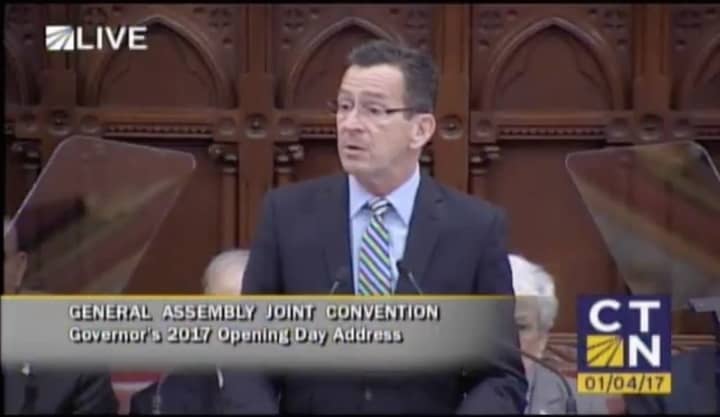What do you think are the top issues facing the state of Connecticut?
- Taxes
- Spending
- Balancing the budget
- Pensions for retired state workers, teachers
- Size of government
Malloy delivered his address to a joint session of the Connecticut General Assembly on Wednesday afternoon, the first day of the new legislative session. In addition to highlighting steps his administration has taken in an effort to improve the state’s economy, as well as a path forward to make state government more efficient, he also addressed uncertainty seen throughout the state and nation as a result of November’s presidential election.
The governor said that deals such as the recent one to keep Sikorsky in the state have helped bring a degree of predictability to the state’s economy. He outlined three steps he believes can continue to make Connecticut’s economic prospects more predictable and sustainable.
“To start, we need to continue making state government leaner and more cost effective,” Malloy said.
He pointed to $850 million that was cut out of the budget last year and work that has been done to reduce the size of government. He said that the number of state agencies has been reduced by 28 percent since 2011, and the executive branch workforce has 5,000 fewer full-time employees than it did in 2008.
“In September, my administration asked agencies to begin thinking about what additional cuts would mean. Having further explored these options, many of their recommendations will be included in the budget that I present to you next month,” he told the legislators.
The second area he addressed was retirement and benefit obligations to state employees. Failure to put aside money for these fixed costs in the past has caused years of stress to be placed on the state’s budget, he said.
“Of the $1.65 billion that we will pay next year into the state’s retirement systems, 78 percent of that – nearly $1.3 billion – is what we’re paying to make up for what past administrations and past legislatures failed to do,” Malloy said.
Through bargaining begun in 2011, the state saved money by changing benefits, restructuring pensions and requiring employees to pay a portion of their post-employment benefits, he said. But fixed costs continue to climb and pension obligations for state employees and teachers are expected to cost an additional $360 million next year, he said.
Malloy said he plans on continuing to work with labor leaders to reach agreements on pension and benefit costs that make them more affordable while still honoring obligations to state employees and retirees.
The budget that Malloy will introduce will also address how the state distributes aids to towns and cities, particularly when it comes to funding education. Malloy said that the state provides $5.1 billion in municipal assistance, 81 percent of which is educational funding.
Malloy said he believes that the state is not spending this money in the best possible way, and that support should be directed to municipalities that are struggling the most.
“We need a formula that appropriately measures a given community’s burden. A formula that recognizes the specific challenges faced by local property taxpayers. And a formula that takes into account the impact those challenges have on the education provided to our children,” he said.
He said the budget he presents will outline a “more equitable system for providing town aid. It will be based on the local property tax burden, on student need and current enrollment” that he believes will result in a “fairer distribution of our state’s limited funds.”
He also said that local municipalities will be held accountable “so that increased aid doesn’t simply mean more spending on local government.”
Malloy said that predictability and stability is particularly important in the wake of November’s presidential election.
“It is now more clear than ever that too many Americans feel disconnected from their government,” he said. “While we might disagree on the role of government in that effort, on whether it should be more active or less, I offer to you that a greater degree of predictability in government – in all government, at all levels – will help reengage and reinvigorate our democracy.”
He also said the presidential transition “has been nothing if not unpredictable.”
“It has left some people and some communities feeling anxious and uncertain, and that is true here in Connecticut,” he said. “But let me remind you of this – our state has a long legacy of acceptance, compassion and fairness. So regardless of whether your family settled in Connecticut 300 years ago or just three days ago, you are welcome here.”
Click here to follow Daily Voice Norwalk and receive free news updates.


